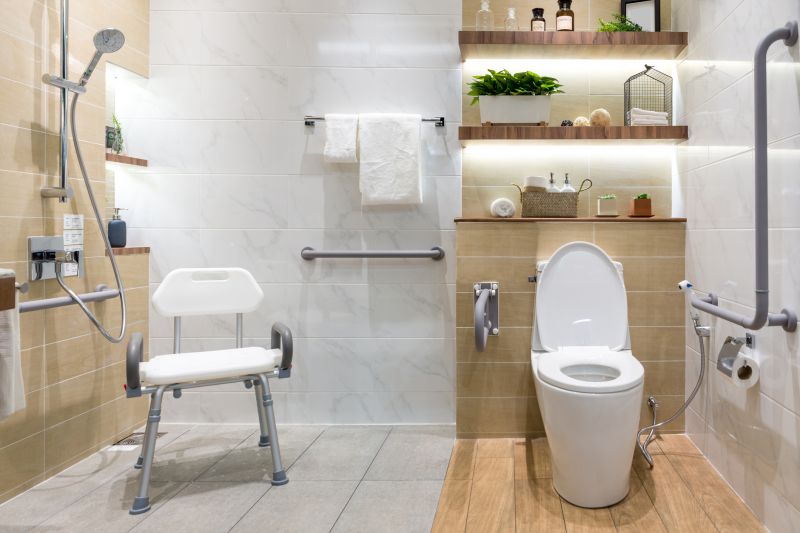Ultimate Guide To Must-Have Products For Handicap Remodelings
Find out which products are favored by experts for creating more accessible and functional living environments.
 Remodeling for accessibility and convenience is essential for creating safe and functional environments for individuals with mobility challenges. A well-designed handicap remodeling project incorporates a variety of products that enhance safety, ease of use, and independence. These products are tailored to accommodate different needs, whether for residential spaces, commercial facilities, or public venues. When planning such modifications, it is important to consider the specific mobility requirements of the user, the layout of the space, and the overall safety standards.
Remodeling for accessibility and convenience is essential for creating safe and functional environments for individuals with mobility challenges. A well-designed handicap remodeling project incorporates a variety of products that enhance safety, ease of use, and independence. These products are tailored to accommodate different needs, whether for residential spaces, commercial facilities, or public venues. When planning such modifications, it is important to consider the specific mobility requirements of the user, the layout of the space, and the overall safety standards.
Top Overall Option
Adjustable Grab Bar System
An adjustable grab bar system provides versatile support options for bathrooms and other areas where stability is essential. These systems often feature flexible mounting positions, high weight capacity, and corrosion-resistant materials, making them suitable for various environments. They are easy to install and can be customized to fit different user needs, offering enhanced safety and confidence during daily activities.
Types of Products For Handicap Remodelings
Wheelchair Ramps
Inclined surfaces designed to provide smooth transitions between different levels, facilitating wheelchair access indoors and outdoors.
Grab Bars and Handrails
Support bars installed in bathrooms, hallways, and stairways to assist with stability and balance.
Accessible Shower Chairs
Seating options that allow safe and comfortable bathing for individuals with limited mobility.
Lowered Sinks and Vanities
Countertops and sinks designed at accessible heights for wheelchair users, ensuring ease of use.
Wide Doorways and Threshold Ramps
Doorway modifications and ramps that facilitate unobstructed passage for wheelchairs and walkers.
Accessible Toilet Fixtures
Elevated toilets, bidet seats, and support bars that improve bathroom accessibility.
Elevating and Adjustable Beds
Beds that can be adjusted for height and positioning to support comfort and mobility.
Non-slip Flooring
Flooring materials that reduce the risk of slips and falls in high-traffic or wet areas.
Automatic Door Openers
Motorized systems that enable hands-free door operation for easier access.
Stair Lifts and Chair Elevators
Motorized chairs designed to assist with traversing stairs safely and comfortably.
Popular Choices
Lightweight ramps that can be moved and stored easily, suitable for temporary or multiple locations.
Support bars that save space and provide reliable stability in bathrooms and showers.
Comfortable and secure seating options for bathing, often with adjustable height features.
Ramps designed to cross small elevation changes without creating tripping hazards.
Sensor-activated systems that provide hands-free entry and exit for improved accessibility.
Vanities designed at lower heights with easy-to-reach storage for wheelchair users.
Seats that increase height for easier sitting and standing, often with support handles.
Devices that assist in transferring mobility scooters into vehicles or onto elevated surfaces.
Floor mats that enhance safety in wet or slippery areas around bathrooms and kitchens.
Automated systems that provide effortless door operation for wheelchair users and those with limited strength.
Accessibility products can range from simple modifications like grab bars to more complex installations such as wheelchair ramps and accessible bathroom fixtures. The goal is to create a space that minimizes obstacles and maximizes ease of movement. Proper planning and selection of products ensure that the remodel not only meets regulatory requirements but also provides a comfortable and welcoming environment.
Choosing the right products involves understanding various features such as load capacity, installation requirements, and compatibility with existing structures. It is also advisable to consider future needs, ensuring that the modifications remain functional and effective over time. With a comprehensive approach, remodeling projects can significantly improve quality of life and independence for individuals with mobility challenges.
In addition to safety and accessibility, aesthetic considerations are also important. Modern products often combine functionality with sleek designs that blend seamlessly into the overall decor. Consulting with professionals and specialists in accessibility can help identify the most suitable options for each unique space, ensuring a successful and compliant remodel.
Key Buying Considerations
- Assess the specific mobility needs of the user to select appropriate products.
- Ensure compatibility with existing structural elements and space constraints.
- Check weight capacities and safety ratings for support products.
- Consider ease of installation and whether professional assistance is required.
- Look for adjustable or customizable features to accommodate changing needs.
- Prioritize slip-resistant surfaces, especially in wet areas.
- Evaluate the durability and corrosion resistance of materials used.
- Ensure compliance with local accessibility standards and regulations.
- Think about aesthetics and how the products will blend with the overall decor.
- Review maintenance requirements and ease of cleaning for long-term usability.
- Determine if the products are suitable for indoor and outdoor use.
- Consider portability if temporary or multi-location use is anticipated.
- Check for warranties or guarantees offered by the manufacturer.
- Assess the availability of support and customer service.
- Plan for future modifications or expansions to the accessible features.
This content contains affiliate links. We may earn a commission if you purchase through these links, which helps support our work and provides you with curated product information.
